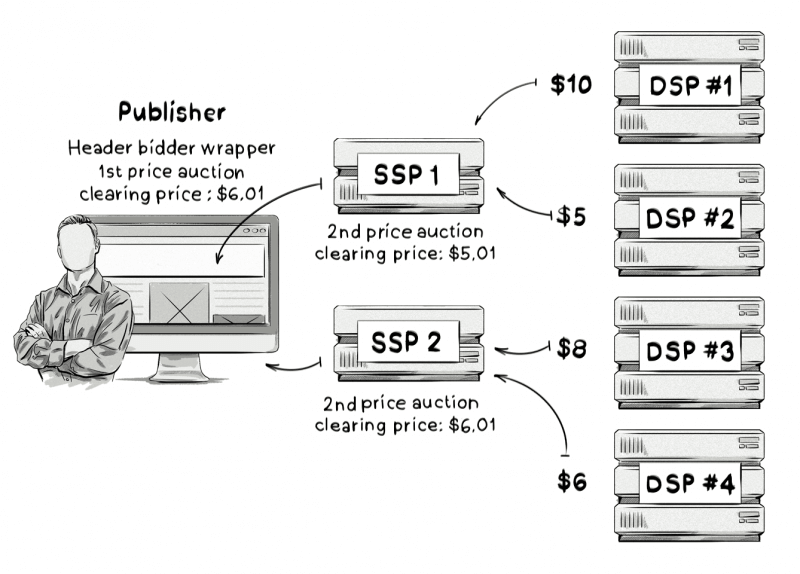Acquire Online believe the move to First Price auctions is a step in the right direction as buyers can now compete for premium inventory which would have otherwise been onsold at a profit or reserved for bigger agencies groups. First price is meant to combat hidden fees being taken from both the buyer and seller but it has its share of problems. e.g. When a publisher is working with multiple Supply Side Platforms (SSP) on different auction dynamics.
New Auction Dynamics
Header bidding was an improvement over the waterfall model in terms of auction dynamics, but it still entails some problems and inefficiencies. These considerations lead to the development of an array of new auction mechanics. Consider this example:
-
A user accesses a website.
-
The header-bidding wrapper makes simultaneous requests to Suppy Side Platforms (SSPs)/ad exchanges.
-
Each SSP/ad exchange broadcasts the bid requests to a number of Demand Side Platforms (DSP) it is connected to.
-
Each DSP responds with the bid responses and the max CPM price the advertiser of the matched campaign is willing to pay ($10, $5, $8, $6).
-
SSPs/ad exchanges execute the second-price auctions (e.g. If the SSP received $10 and $5 bids, the winner is paying $5.01 CPM—the clearing price).
-
The SSPs returns the $5.01 clearing price to the header-bidding wrapper.
-
The header-bidding wrapper chooses the highest clearing price (first-price auction) and displays the impression.

How can this system be inefficient? Because there was, in fact, another buyer willing to pay more (the $10)
The example above illustrates the inefficiency of the currently used header-bidding auction process. DSP 1’s $10 bid did not winning against DSP 3’s $8 bid because the SSP 1 runs a second-price auction (with a $5.01 clearing price), which loses to SSP 2’s clearing price of $6.01.
However, because there weren’t any high bidders at the SSP level, the clearing price of the second-price auction was just $5.01, less than on the other SSP level. This is a wasted opportunity for profit that publishers want to avoid.
When DSP can pass information like auction type, floor CPM and winning bids, buyers and algorithms can be trained to better understand how the market/SSP is valuing each impression and bid smarter depending on the real supply/demand curve at the time.
*Source: Clearcode
